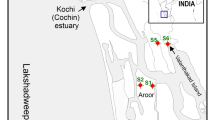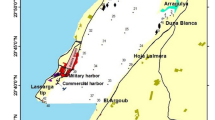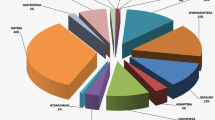Abstract
Macroinvertebrate assemblages associated with six aquatic macrophyte species were investigated in Nigeen Lake of Kashmir valley, Jammu and Kashmir. Across the lake surface, four locations were selected for collection of the aquatic macrophytes. The macrophytes were collected in plastic bags, labelled, and brought to laboratory for further analysis. The samples were sieved using a 0.5 mm mesh, sorted, and identified. During the study period, 18 macroinvertebrate species were recorded from 6 macrophytes. The macroinvertebrates belonged to eight families, seven orders, and extend over three phyla, viz.: Mollusca, Arthropoda, and Annelida. Phylum Arthropoda comprised of highest number (11) of species, followed by Mollusca (4), and Annelida (3). Maximum number of individuals was found attached to Myriophyllum verticillatum (75 ind./m2), Potamogeton crispus (71 ind./m2), Trapa natans (60 ind./m2), Potamogeton natans (57 ind./m2), Ceratophyllum demersum (38 ind./m2), and least for Potamogeton lucens (19 ind./m2). Principal component analysis (PCA) of the data resulted in two principal components (PCs) with eigenvalues > 1, explaining 86% of variance. Investigation of the factor loadings of macroinvertebrate assemblages linked with aquatic macrophytes on the first two PCs of the dataset revealed that relationship exhibit habitat gradients potentially affecting associated macroinvertebrates. The study demonstrated that macroinvertebrates differed with different vegetation types in terms of both density and diversity, and that plant structure plays a significant role in determining this variation. Macroinvertebrate communities benefit from increased macrophyte productivity. The study concludes that the certain taxa of macroinvertebrates are more comfortable to the high pollution loads and nutrient enrichment in the Nigeen lake.





Similar content being viewed by others
Data availability
The datasets generated during and/or analyzed during the current study are available from the corresponding author on reasonable request.
References
Albertoni EF, Prellvitz LJ, Palma-Silva C (2007) Macroinvertebrate fauna associated with Pistia stratiotes and Nymphoides indica in subtropical lakes (south Brazil). Braz J Biol 67:499–507. https://doi.org/10.1590/S1519-69842007000300015
Alonso Á, Camargo JA (2010) Comparison of two methods for estimating the abundance, diversity and habitat preference of fluvial macroinvertebrates in contrasting habitats. Limnologica 40(1):23–29. https://doi.org/10.1016/j.limno.2009.03.002
Andrews JD, Hasler AD (1943) Fluctuations in the animal populations of the littoral zone in Lake Mendota. Trans Wis Acad Sci Arts Lett 35:175–186. http://pi.lib.uchicago.edu/1001/cat/bib/6373350
Baron JL, Ostrofsky ML (2010) The effects of macrophyte tannins on the epiphytic macroinvertebrate assemblages in sandy lake. Pa J Freshw Ecol 25:457–465. https://doi.org/10.1080/02705060.2010.9664389
Baturina MA, Fefilova EB (2021) Estimating the Biodiversity Level of the Pechora River Delta Freshwater Ecosystems by the structure of bottom communities of Cladocera, Copepoda, and Oligoсhaeta. Inland Water Biol 4:709–721. https://doi.org/10.1134/S199508292106002X
Bazhenova OP, Mikhailov VV (2021) Phytoplankton as an Indicator of the Modern Ecological State of the Novosibirsk Reservoir. Inland Water Biol 14:670–678. https://doi.org/10.1134/S1995082921050023
Bhat SU, Dar GA, Sofi AH, Dar NA, Pandit AK (2012) Macroinvertebrate community associations on three different macrophytic species in manasbal lake. Res J Environ Sci 6:62–76
Chowdhary S, Sharma KK (2013) Evaluation of macrobenthic invertebrates in the longitudinal profile of a river (Tawi), originating from Shivalik Hills. J Glo Biosci 2:31–39
Christoffersen KS (2008) Emergent and floating-leaved macrophytes as refuge for zooplankton in a eutrophic temperate lake without submerged vegetation. Hydrobiologia 605:113–122. https://doi.org/10.1007/s10750-008-9324-1
Czarnoleski M, Kozlowski J, Kubajak P, Lewandowski K, Muller T, Stanczykowska A, Surowka K (2006) Cross-habitat differences in crush resistance and growth pattern of zebra mussels (Dreissena polymorpha): effects of calcium availability and predator pressure. Arch Hydrobiol 165:191–208
Damanik-Ambarita M, Everaert G, Forio M, Nguyen T, Lock K, Musonge P, Suhareva N, Dominguez-Granda L, Bennetsen E, Boets P, Goethals P (2016) Generalized Linear models to identify key hydromorphological and chemical variables determining the occurrence of Macroinvertebrates in the Guayas River Basin (Ecuador). Water 8(7):297. https://doi.org/10.3390/w8070297
Dar SA, Bhat SU, Aneaus S, Rashid I (2020a) A geospatial approach for limnological characterization of Nigeen Lake, Kashmir Himalaya. Environ Monit Assess 192:1–18. https://doi.org/10.1007/s10661-020-8091-y
Dar SA, Bhat SU, Rashid I, Dar SA (2020b) Current status of wetlands in Srinagar City: threats, Management Strategies, and future perspectives. Front Environ Sci 7:1–11. https://doi.org/10.3389/fenvs.2019.00199
Dar SA, Rashid I, Bhat SU (2021a) Land system transformations govern the trophic status of an urban wetland ecosystem: perspectives from remote sensing and water quality analysis. Land Degrad Dev 32:4087–4104. https://doi.org/10.1002/ldr.3924
Dar SA, Bhat SU, Rashid I (2021b) The Status of Current Knowledge, Distribution, and Conservation Challenges of Wetland Ecosystems in Kashmir Himalaya, India. In (eds S. Sharma and P. Singh), Wetlands Conservation: Current Challenges and Future Strategies 175–200. https://doi.org/10.1002/9781119692621.ch10
Dar SA, Bhat SU, Rashid I (2021c) Landscape transformations, Morphometry, and Trophic Status of Anchar Wetland in Kashmir Himalaya: implications for Urban Wetland Management. Water Air Soil Pollut 232:1–19. https://doi.org/10.1007/s11270-021-05416-5
Dar SA, Rashid I, Bhat SU (2021d) Linking land system changes (1980–2017) with the trophic status of an urban wetland: implications for wetland management. Environ Monit Assess 193:1–17. https://doi.org/10.1007/s10661-021-09476-2
Dar SA, Hamid I, Bhat SU, Rashid I (2022) Identification of anthropogenic contribution to wetland degradation: insights from the environmetric techniques. Stoch Environ Res Risk Assess 36:1397–1411. https://doi.org/10.1007/s00477-021-02121-x
Dar SA, Rashid I, Bhat SU (2023) Demystifying the impacts of dredging on the physicochemical characteristics of wetland sediments in Kashmir Himalaya. J Hazard Mater Adv 10(100303):1–11. https://doi.org/10.1016/j.hazadv.2023.100303
De M, Roy C, Medda S, Roy S, Dey SR (2019) Diverse role of macrophytes in aquatic ecosystems: a brief review. Int J Exp Res Rev 19:40–48. https://doi.org/10.52756/ijerr.2019.v19.005
Divya PV, Sanilkumar MG (2021) Phytoplankton Diversity and Environmental Drivers in a backwater Inlet of Central Kerala, Southwest India. Inland Water Biol 14:691–698. https://doi.org/10.1134/s1995082921110018
Dvorak J, Best EPH (1982) Macro-invertebrate communities associated with the macrophytes of Lake Vechten: structural and functional relationships. Hydrobiologia 95:15–126. https://doi.org/10.1007/BF00044479
Feldman RS (2001) Taxonomic and size structures of phytophilous macroinvertebrate communities in Vallisneria and Trapa beds of the Hudson River, New York. Hydrobiologia 452:233–245. https://doi.org/10.1023/A:1011903315998
Gallardo LI, Carnevali RP, Porcel EA, Poi ASG (2017) Does the effect of aquatic plant types on invertebrate assemblages change across seasons in a subtropical wetland? Limnetica 36:87–98. https://doi.org/10.23818/limn.36.07
Habib S, Yousuf AR (2016) Phytophilous macroinvertebrate community of an eutrophic lake in Kashmir Himalayas. J Entom Zool Stud 4:318–325
Islam ST, Dar SA, Sofi MS, Bhat SU, Sabha I, Hamid A, Jehangir A, Bhat AA (2021) Limnochemistry and plankton diversity in some high Altitude Lakes of Kashmir Himalaya. Front Environ Sci 9:1–16. https://doi.org/10.3389/fenvs.2021.681965
Jan A, Pandit AK, Shah JA (2015) Diversity and Abundance of Zooplankton in Nigeen Lake of Kashmir Himalaya. Egypt Acad J Biol Sci B Zool 7:39–50. https://doi.org/10.21608/EAJBSZ.2015.13471
Javaid I, Sabha I, Qayoom U, Bhat SU (2018) Diversity and density patterns of macroinvertebrates on different macrophytes in Dal Lake, Kashmir. J Himal Ecol Sustain Dev 13:11–25
Kratzer EB (2002) Temporal and spatial variation of wetland macroinvertebrates of the Okefenokee swamp, M.Sc thesis, Athens, Georgia
Lycarião TA, Dantas EW (2017) Interactions between different biological forms of aquatic macrophytes in a eutrophic tropical reservoir in Northeastern Brazil. Rev Biol Trop 65:1095–1104
McAbendroth L, Ramsay PM, Foggo A, Rundle SD, Bilton DT (2005) Does macrophyte fractal complexity drive invertebrate diversity, biomass and body size distributions? Oikos 111:279–290. https://doi.org/10.1111/j.0030-1299.2005.13804.x
McCafferty WP, Provonsha AV (1998) Aquatic entomology. Jones and Bartlett Publishers Toronto Canada, p 45
Mohamed ZA (2017) Macrophytes-cyanobacteria allelopathic interactions and their implications for water resources management—A review. Limnologica 63:122–132. https://doi.org/10.1016/j.limno.2017.02.006
Nabi M (2021) Heavy metals accumulation in aquatic macrophytes from an urban lake in Kashmir Himalaya, India. Environ Nanotechnol Monit Manag 16:1–10. https://doi.org/10.1016/j.enmm.2021.100509
Nissa M, Bhat SU (2016) An Assessment of Phytoplankton in Nigeen Lake of Kashmir Himalaya. Asian J Biol Sci 9:27–40. https://doi.org/10.3923/ajbs.2016.27.40
Pennak WR (1978) Freshwater invertebrates of United States. Willy- interscience publishing, New York, p 78
Prokin AA, Seleznev DG (2021) Structure of Macrozoobenthos in Floodplain Lakes under conditions of different durations of spring flooding. Inland Water Biol 14:573–580. https://doi.org/10.1134/S1995082921050126
Rashid I, Aneaus S, Dar SA, Javed O, Khanday SA, Bhat SU (2023) A novel GIS-based multicriteria analysis approach for ascertaining the catchment-scale degradation of a himalayan wetland. Environ Res 229:115967
Rather MI, Yousuf AR, Zargar UR (2020) Deweeding as a lake management intervention- A critical analysis. J Himal Ecol Sustain Dev 15:6–14
Rezende RDS, Monção FS, Junior GFJ, dos Santos AM (2019) Macroinvertebrate associated with macrophyte beds in a Cerrado stream. Limnetica 38(2):639–652
Rundle SD, Spicer JI, Coleman RA, Vosper J, Soane J (2004) Environmental calcium modifies induced defences in snails. Proc R Soc B 271:S67-S70
Šetlíková I, Bláha M, Edwards-Jonášová M, Dvořák J, Burianová K (2016) Diversity of phytophilous macroinvertebrates in polycultures of semi-intensively managed fishponds. Limnologica 60:59–67. https://doi.org/10.1016/j.limno.2016.07.001
Strayer DL, Malcom HM (2007) Submersed Vegetation as Habitat for invertebrates in the Hudson River Estuary. Estuaries Coast 30:253–264. https://doi.org/10.1007/BF02700168
Strayer DL, Lutz C, Malcom HM, Munger K, Shaw WH (2003) Invertebrate communities associated with a native (Vallisneria americana) and an alien (Trapa natans) macrophyte in a large river. Freshw Biol 48:1938–1949. https://doi.org/10.1046/j.1365-2427.2003.01142.x
Taniguchi H, Nakano S, Tokeshi M (2003) Influences of habitat complexity on the diversity and abundance of epiphytic invertebrates on plants. Freshw Biol 48(4):718–728
Tessier CA, Cattaneo B, Pinel-Alloul C, Hudon, Borcard D (2008) Invertebrate communities and epiphytic biomass associated with metaphyton and emergent and submerged macrophytes in a large river. Aquat Sci 70(1):10–20
Thomaz SM, da Cunha ER (2010) The role of macrophytes in habitat structuring in aquatic ecosystems: methods of measurement, causes and consequences on animal assemblages’ composition and biodiversity. Acta Limnol Bras 22(2):218–236. https://doi.org/10.4322/actalb.02202011
Walker PD, Wijnhoven S, van der Velde G (2013) Macrophyte presence and growth form influence macroinvertebrate community structure. Aquat Bot 104:80–87. https://doi.org/10.1016/j.aquabot.2012.09.003
Wetzel RG, Likens G (2000) Limnological analyses. Springer (India) Publisher Private Limited, New Delhi. p 160
Zalizniak L, Kefford BJ, Nugegoda D (2009) Effects of different ionic compositions on survival and growth of Physa acuta. Aquat Ecol 43:145–156
Zelnik I, Gregorič N, Tratnik A (2018) Diversity of macroinvertebrates positively correlates with diversity of macrophytes in karst ponds. Ecol Eng 117:96–103. https://doi.org/10.1016/j.ecoleng.2018.03.019
Acknowledgements
The authors thank the Department of Environmental Science, University of Kashmir for providing laboratory facilities and bearing the expenses of hiring the motor boat for collection of samples in the Nigeen Lake. Authors wish to extend their gratitude to the anonymous reviewers for their suggestions which improved the overall quality of the manuscript.
Funding
The authors have not received any funding for carrying out this study.
Author information
Authors and Affiliations
Corresponding author
Ethics declarations
Ethics approval and consent to participate
Research ethics stand adhered while submitting the manuscript. All the authors approved the manuscript to be published
Competing interests
The authors declare that they have no conflict of interest.
Electronic supplementary material
Below is the link to the electronic supplementary material.
Rights and permissions
Springer Nature or its licensor (e.g. a society or other partner) holds exclusive rights to this article under a publishing agreement with the author(s) or other rightsholder(s); author self-archiving of the accepted manuscript version of this article is solely governed by the terms of such publishing agreement and applicable law.
About this article
Cite this article
Dar, S.A., Gulzar, S. & Bhat, S.U. Phytophilous macroinvertebrate assemblages in Nigeen lake of Kashmir Himalaya. Trop Ecol (2024). https://doi.org/10.1007/s42965-024-00341-0
Received:
Revised:
Accepted:
Published:
DOI: https://doi.org/10.1007/s42965-024-00341-0




